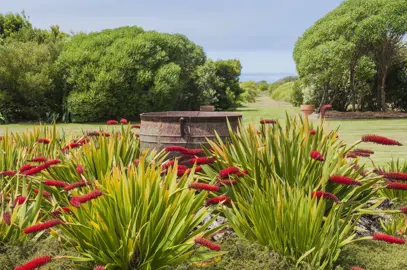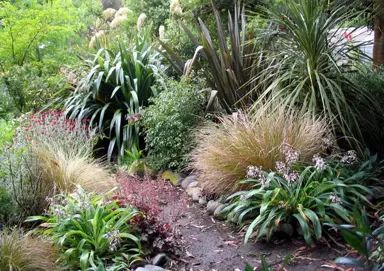
The Plant Company grows and sells thousands of Westringia plants throughout NZ. We pride ourselves on producing high quality plants and seeing the joy from our customers when they receive them. We do hope you enjoy them and support this NZ business that is passionate about Westringia plants.
Westringia Aussie Box is a variety of the commonly known, Coastal Rosemary, and is a popular fast-growing, bushy shrub. It has fine and narrow, dark...
Westringia Blue Gem is a variety of the commonly known, Coastal Rosemary, and is a popular, fast-growing shrub. It features fine and narrow, green...
Westringia brevifolia, commonly known as Coastal Rosemary, is a popular and fast growing, evergreen shrub. It features narrow, grey-green leaves...
Westringia fruticosa, commonly known as Coastal Rosemary, is a fast-growing, evergreen shrub. It features narrow, grey-green leaves held densely on...
Westringia 'Grey Box' is a variety of the commonly known Coastal Rosemary, and is a popular, fast-growing shrub. It features delicate, narrow, grey...
Westringia Lilac and Lace is a variety of the commonly known, Coastal Rosemary, and is a fast-growing, bushy shrub. It has fine and narrow leaves...
Westringia 'Low Horizon' is a variety of the commonly known Coastal Rosemary, and is a fast-growing shrub. It features narrow grey-green leaves held...
Westringia 'Mundi' is a variety of the commonly known Coastal Rosemary, and is grown for its lovely foliage and great form. It grows as a spreading...
Westringia Smokey is a variety of the commonly known, Coastal Rosemary, and is a fast growing, bushy shrub renowned for its colourful foliage. It has...
Westringia Wynyabbie Gem is a variety of the commonly known, Coastal Rosemary, and is a fast growing, bushy shrub. It has narrow, mid-green leaves...
Westringia Wynyabbie Highlight is a fast growing and very attractive shrub. It features fine and narrow leaves which are variegated cream and dark...
Westringia Edna Walling Rosemary is a variety of the commonly known, Coastal Rosemary, and is a popular fast-growing, bushy shrub. It features small...
Westringia fruticosa Variegated is a fast-growing, evergreen shrub renowned for its foliage and flowers. It features fine and narrow leaves which are...
Westringia fruticosa Zena is a variety of the commonly known, Coastal Rosemary, and is a fast-growing, bushy shrub. It has narrow, dark green-grey...
Westringia Funky Chunky is a variety of the commonly known, Coastal Rosemary, and is a fast-growing, bushy shrub. It has narrow, dark green-grey...
Westringia Glabra Cadabra is a variety of the commonly known, Coastal Rosemary, and is a popular fast-growing, bushy shrub. It features small green...
Westringia Green Box is a variety of the commonly known, Coastal Rosemary, and is a popular fast growing, bushy shrub. It has fine and narrow, dark...
Westringia Jervis Gem is a variety of the commonly known, Coastal Rosemary, and is a popular, fast-growing shrub. It features fine and narrow, green...
Westringia longifolia is a variety of the commonly known, Coastal Rosemary, and is a popular fast-growing, bushy shrub. It features small, dark green...
Westringia Mauve Skies is a variety of the commonly known, Coastal Rosemary, and is a popular fast-growing, bushy shrub. It features small green...
Westringia Morning Light is a fast growing, evergreen shrub renowned for its foliage and flowers. It features fine and narrow leaves which are...
Westringia Naringa is a variety of the commonly known, Coastal Rosemary, and is a popular fast-growing, bushy shrub. It features small green-grey...
Westringia White Rambler is a variety of the commonly known, Coastal Rosemary, and is grown for its lovely foliage and great form. It grows as a...
Growing colourful shrubs in your garden such as Westringia fruticosa (Coastal Rosemary) delivers a vast range of benefits:
We have the largest variety of Coastal Rosemary, including Westringia Wynyabbie Gem, Westringia Mundi, and the right one for your space. Our plants have been selected to thrive in NZ’s climate. We grow and stock only the highest quality plants, sourcing them locally, and from NZ’s leading nurseries. Each plant is packed and transported with extreme care, ensuring it arrives to you in the same condition it was in when it left the nursery. If you are wanting to buy Westringia, shop with confidence from the best in the industry.
Westringia, a genus of flowering shrubs native to Australia, is known for its attractive foliage, long-lasting blooms, and adaptability to various growing conditions. They do need a few things to grow successfully:
Westringia is a genus of flowering shrubs native to Australia, known for their attractive foliage, long-lasting flowers, and adaptability to various growing conditions. Some of their key characteristics include:
Westringia is an adaptable and versatile plant, making it a great choice for pairing with various companion plants in your garden. Here are some suggestions for plants that complement Westringia's characteristics:
Westringia 'White' is a small to medium-sized shrub that typically grows to a height of 1-2 meters (3-6 feet) and a spread of 1-2 meters (3-6 feet). It has a dense, bushy habit with fine, silvery-green leaves and small, white flowers that bloom in clusters from spring through summer.
The tallest growing Westringia variety is Westringia 'Naringa', also known as Naringa Coast Rosemary. It is a fast-growing shrub that can reach heights of up to 2.2 meters (7 feet) and a width of 1.5 meters (5 feet). Naringa is known for its dense, bushy habit, attractive silvery-green foliage, and masses of mauve flowers that bloom in spring and sporadically throughout the year.
Westringia is a genus of flowering shrubs native to Australia. It is commonly known by several names, including:
In addition to these common names, Westringia is also sometimes called by its species name. For example, Westringia fruticosa is sometimes called "grey box" or "native grey box."
The lowest growing Westringia variety is Westringia 'Low Horizon', also known as Low Horizon Coast Rosemary. It is a dwarf, compact shrub that typically reaches a height of only 0.3 meters (1 foot) and a width of 0.7 meters (2.3 feet). Its dense, bushy habit and attractive silvery-green foliage make it a popular choice for groundcovers, borders, and rockeries.
Westringia Mundi is a low-growing, spreading shrub that typically reaches a height of 40-50 cm and a width of 1.5 m. It has small, grey-green leaves and white flowers during spring and summer.
Westringia fruticosa 'Blue Gem' is a compact, upright shrub that typically reaches 1-1.5 meters tall and 1-1.3 metres wide. It has dense, fine-textured foliage with narrow, olive-green leaves on dark stems. It flowers profusely in spring, with blue-purple flowers that can also appear at other times of the year.
While the origin of the Westringia genus is Australia, the specific cultivar Westringia fruticosa 'Mundi' is actually a hybrid and not a naturally occurring species.
Here's what we know about its origin:
Westringia Mundi is commonly referred to as Coastal Rosemary. This is because it shares many characteristics with the true coastal rosemary (Westringia fruticosa):
While not technically the same species as true coastal rosemary, Westringia Mundi has earned the nickname for its remarkable adaptability to coastal conditions and its close resemblance to its relative.
The Plant Company has produced a suite of short articles that cover everything you could want to know about Westringia care and everything you would want to know about growing Westringia. They are well worth the read!
https://www.theplantcompany.co.nz/expert-advice/westringia
Whether you need assistance finding the plant you’re looking for or you simply want to know more about who we are and what we do, we invite you to get in touch with us today. A member of The Plant Company team will get back in touch as soon as possible.


